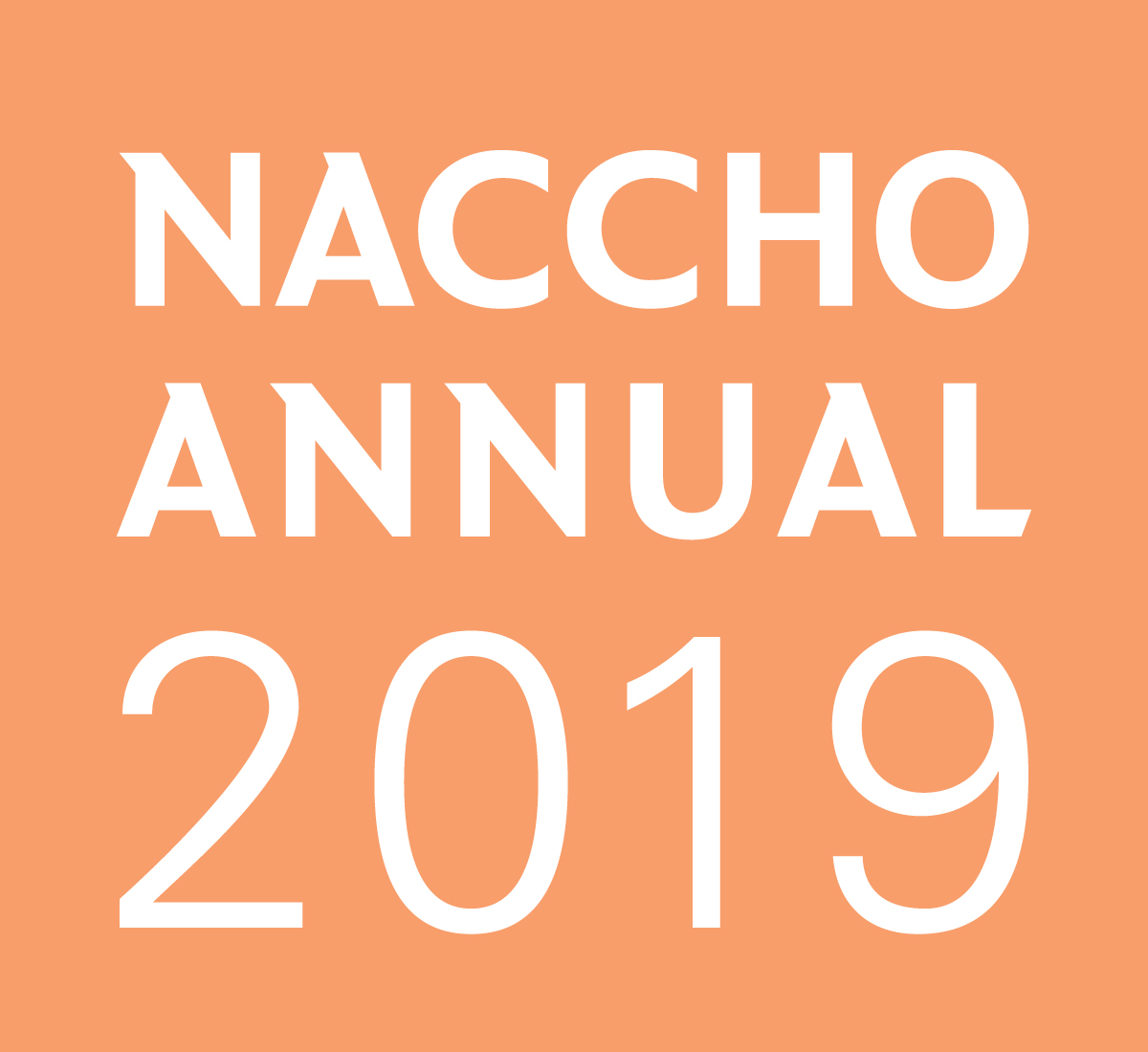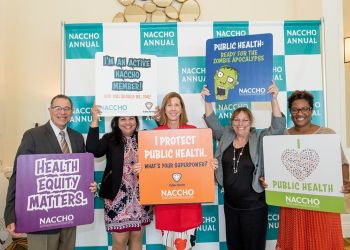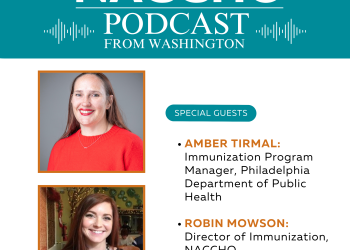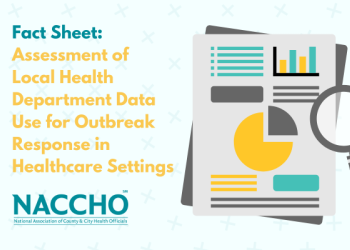 Interview by Taylarr Lopez, Communications Specialist
Interview by Taylarr Lopez, Communications Specialist
Nasseam McPherson James, MBA, MSW, is the Interim Health Officer for the Florida Department of Health in Orange County (FL DOH). In the following post, she discusses her role within the department, shares how FL DOH in Orange County is addressing infant mortality and decreasing new HIV infection rates, and highlights ways in which other local health departments can prepare themselves to address public health challenges for decades to come.
Tell us about your role as Assistant County Health Department Director for the Florida Department of Health in Orange County. What are you currently working on? What does an average day looks like for you?
Since 2012, I’ve served the Florida Department of Health (DOH) in various leadership roles, but when I transitioned to Deputy Health Officer and Assistant Director of Operations position in 2018, I knew I was walking into my purpose. The ability to impact health equity and be a catalyst for change in public health is so exciting. It has been a wild adventure with roadblocks, triumphs, challenges, and opportunities but I can honestly say I love it.
Currently, I’m serving as the Interim Health Officer; Dr. Kevin Sherin previously held that position but he is now embarking on his well-deserved retirement. It’s a big role with many responsibilities but I’m proud to serve Orange County in the interim as our state office identifies our next Health Officer.
My days are anything but average. Daily, I drive the mission and vision of the department into the operations and programs that serve our community. Orange County is unique and beautiful with its own set of health care needs. My job is to ensure those public health needs are being met through our many programs and services. Did you know that DOH Orange offers 79 different services and resources? Our residents deserve to experience quality and top-notch customer service. I take quality seriously and my typical day is spent ensuring health quality assurance is evident in everything we do.
Since my days are never the same I’ll talk about how I start my day. Though I’m not a morning person, every day I’m up by 5:30 AM. It’s a habit I’ve developed because I enjoy the hour of quiet that I get before my household starts to stir. During that hour, I sip tea and meditate, read, or stretch with the help of my yoga app. I believe that hour helps me to be a better leader, mom, and wife because I take that time every day to devote to myself.
Each morning, I write a short list of priorities for the day, then I’m off to work with my 4-year-old in tow. During the car ride to my son’s preschool, we typically spend the next 30 minutes singing or just conversing about topics seen through the lenses of a 4-year-old, which I find to be quite interesting.
Once at the office, I jump into work mode and immediately call my executive assistant, Karen. For the next 20 minutes, we go over my meetings and identify any schedule conflicts that may arise. Karen is great and she keeps me on point.
I try to check email for no more than 15 minutes when I arrive at the office—any more time than that makes it difficult to leave my desk. After checking emails comes phone calls, then making my rounds throughout the office to talk to people as they start the day. I want to know what’s happening with our team members. I’m interested in what everyone is working on and this is when I find out how truly awesome our employees are. I check in with leadership to give an update on any important current events. Community meetings, one-on-one coaching meetings with my direct reports, and working through reports and metrics can easily occupy the remainder of my day. Although I plan my mornings to keep myself organized and sane, there is nothing routine about what I do.
Please tell us about the community your department serves.
Orange County is located in Central Florida and is home to over 1.3 million residents. It is the 16th fastest growing county in the state. Orlando is the largest city in the county and is also the largest inland city in Florida. Known as the “City Beautiful,” Orlando has positioned itself as a tech center and a city of the 21st century. Tourism is one of the main drivers to the local economy. Each year, the area welcomes over 70 million national and international visitors to add to our robust population. Based on the numbers, Orange County is a diverse metropolitan area with 39.8 percent of the population identifying as white; 19.5 percent identifying as black; 5.1 percent identifying as Asian; and 31.4 percent identifying as Hispanic. Hispanics are the largest ethnic minority in Orange County. In concert with the surrounding counties of Seminole, Brevard, Osceola, and Lake, the Central Florida region is the 47th largest economy globally.
The Florida Department of Health in Orange County has twelve locations throughout the county in order to better serve our community. The department’s Women, Infant, and Children (WIC) program serves over 33,000 clients each month and provides an economic boost to the economy to the tune of $28 million. Immunization averages just under 27,000 vaccinations annually, the Epidemiology program investigated over 3,000 reportable infectious disease cases last year, and the Environmental Health program provided 62,574 services, in terms of permits and inspections.
What are some of the most pressing public health challenges your community is facing and how is your department addressing those issues?
We have so many great public health professionals in this community addressing the needs of our residents every day. DOH Orange is vigilant in creating health equity in many areas. The DOH Orange has two high priorities aligned with the statewide strategic plan, which include reducing the infant mortality rate and reducing the HIV new infection rate while increasing the proportion of people living with a suppressed viral load.
We strive to help reduce infant mortality rate through targeted efforts within zip codes with the highest rates. However, since Orange County is a large urban area with stark disparities in perinatal outcomes, we must ensure that our efforts are not only intentional but are appropriate for the populations we serve. In 2017, the Black non-Hispanic infant death rate was 15.5 per 1000 live births. This rate was significantly higher than the Hispanic infant death rate at 5.5 and more than twice the White non-Hispanic rate of 3.8 per 1,000 live births.
To address these disparities, DOH Orange partners with the local community to attack infant mortality from all angles. Partners such as our Healthy Start Coalition of Orange County, Federal Health Resources and Services Administration, the local hospital systems, Early Head Start, Special Supplemental Nutrition Program for WIC, the Department of Children and Families, and many more assist us through providing funding support and wrap around services to woman and their infants and families. Through a network of providers, Orange County provides a safety net of services that address safe sleeping cribs, car seat safety, parenting support and coaching, prenatal education, education for fathers, and substance abuse and treatment services, just to name a few. Most recently, DOH Orange has ramped up a Fetal Infant Mortality Review team. This team, comprised of local community members, will examine fetal and infant deaths, identify potential causes, and then engage the community for actionable strategies and opportunities for prevention. It’s an awesome opportunity for Orange County, so more to come on this.
Next, our HIV/AIDS epidemic is at the forefront of our minds when we think of opportunities. According to the Centers for Disease Control and Prevention’s 2017 HIV Surveillance Report, the Orlando Metropolitan Area (Orlando-Kissimmee-Sanford) is ranked second in the country for new HIV case rates. Orange County ranks third in the state for both newly diagnosed HIV cases and Persons Living with HIV in 2017.
DOH Orange is addressing these startling statistics through our prevention efforts. We are in the community breaking down barriers to treatment by providing education and informing the public about the infection and making is acceptable to seek treatment. We educate the public about how fear and stigma have contributed to people avoiding testing and we show up everywhere to create opportunities for people to find out their status. Our Area 7 Prevention team are rock stars. This group is leading the charge in HIV prevention for DOH Orange through targeted testing and ensuring inclusive materials are available to the community. They are at every event and community opportunity encouraging Talk, Test, and Treat. I can’t mention prevention efforts without mentioning Pre-exposure prophylaxis (PrEP). DOH Orange started providing PrEP services in April 2018. This service offers education and HIV medication to high risk individuals to lower their chances of getting infected. PrEP is over 90 percent effective in preventing HIV transmission from sex but it isn’t birth control and does not prevent the transmission of other STIs, so participants are encouraged to always wear condoms.
What advice do you have for other local health departments that are trying to innovate and adapt to the challenges facing local public health in the next decade?
I would advise other local health departments to stay updated on what is happening in their own back yards. It’s not enough to have a seat at the table. Local health departments need to start the conversation and ensure that it is providing the community with the most accurate and up-to-date information available. We have the talent and access to the information. We need to educate and inform the community about what the data shows but that’s just scratching the surface. What does it mean for communities with limited resources and low access to care to innovate? It means find out where the unmet needs lie and create opportunities with your local partners to address them. It’s not simple but it is necessary. For example, it’s not enough to report that your community has a viral suppression rate of over 80 percent—know what’s happening with the other 20 percent that is unsuppressed. That is where you innovate. Those are where the opportunities to adapt lie.
Local health departments need to be the chief health strategist and champion for public health as our environments change. Drive the initiatives and keep your workforce knowledgeable about the research supporting these initiatives—that aligns with Public Health 3.0. We must drive the efforts that help communities address the who, what, where, when, why, and how. Also, be forward thinking and don’t be afraid of leverage our partners in the private sector. You will run into roadblocks, limited resources, and tasks that seem too big to tackle but push through because our communities depend on us.

What are some fun and interesting things you recommend NACCHO Annual 2019 attendees do while in Orlando?
There is so much to do and see in Central Florida. I recommend that all participants explore the Visit Orlando website before they arrive. That website will provide tons of information about food, fun, and experiencing the local area. The local chamber of commerce website is another I would recommend. Personally, I encourage getting to Orlando early or stay a little later so you have time for the amusement parks in the area.
Florida is the Sunshine State so expect warm July temperatures, perfect for outdoor exploration of our many amusement parks. Most visitors try to visit Disney and Universal Studies. It’s a sure way to keep everyone happy and entertained if traveling with a family. Within the city of Orlando there are plenty of opportunities for visitors besides the traditional destinations. Restaurants, shopping, nightlife, entertainment, and outdoor activities are abundant in the area surrounding the Hilton Bonnet Creek Hotel where the conference is being held. Be sure to visit Disney Springs and explore the many dining options offered there to fit all budgets. International drive is a visitor favorite with plenty to do and see. Orlando’s wonderful downtown has a great, relaxed atmosphere.
If you like art and history, checkout the Orlando Museum of Art and the Orange County Regional History Center. Another gem for the Einsteins among us, is the exhibits at Orlando Science Museum, where science and learning mix. If attendees are in the mood for a leisurely and relaxing stroll, explore the Harry P. Leu Gardens where there are 50-acres of beautiful cultivated gardens with over 40 diverse plant collections and butterfly galore. I could go on about the many offerings here because I’m so excited to share our great community with the NACCHO Annual attendees.
Learn more about NACCHO Annual and register at www.nacchoannual.org. For more information about the Florida Department of Health in Orange County and their services and resources, click here.





